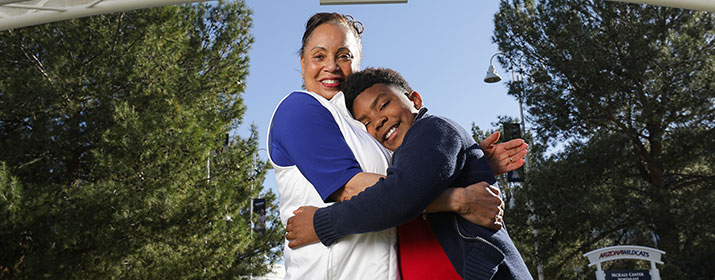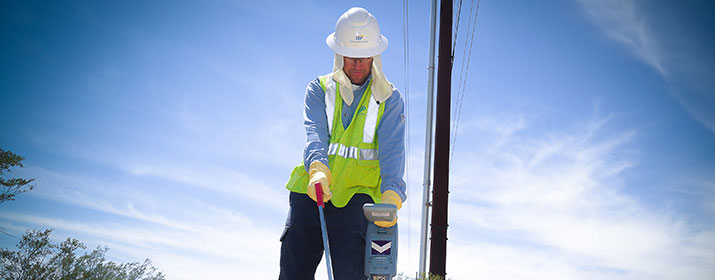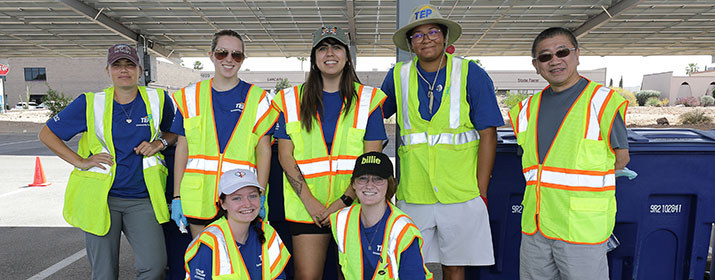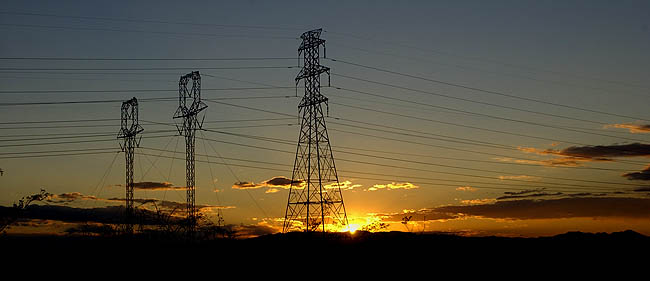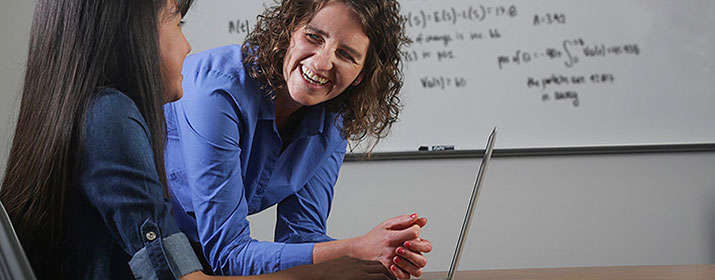
Energy is complex, but teaching it doesn’t have to be.
In appreciation of the role teachers play in shaping smart energy consumers, we’ve developed resources that are ready for classroom use. Energize your lesson plans with these six tips, developed by a teacher who joined TEP for the summer through a partnership with the University of Arizona (more about that below).
1. Leverage Virtual Programming
TEP provides ready-made lessons for students at all levels. In addition to inviting our presenters into your classroom, you can take advantage of our virtual presentations, which offer additional flexibility. Here’s how you can use them in your classroom:
TEP Bright Students is an energy education program primarily for fourth through eighth graders.
Part 1 : Consider setting up stations with simple items that your students can try to open by applying more and less energy, such as a pickle jar and a Play-Doh container. It’s a way to demonstrate that it takes more energy to light up some lightbulbs. Before the video, you can teach your students about renewable and non-renewable resources, such as coal and wind power. Draw up a chart with columns for renewable and non-renewable resources so that during the video, students can yell out items to add to the chart when they come up. After the video, you can have your students virtually build a simple series circuit by combining digital items on screen to make a lightbulb light up. Teacher directions are available with a free membership here: Circuit Construction Kit: DC – Series Circuit | Parallel Circuit | Ohm’s Law – PhET Interactive Simulations (colorado.edu) You can also investigate electromagnetic energy with a guide from the STEMAZing Project.
Part 2: Use the video to help raise student awareness about renewable resources. Consider asking them to do more research in order to create posters or presentations about solar, wind or even battery projects. There are many free digital books on the Epic Books for Kids website and many energy resources for teachers and students on the National Energy Education Development Website. Students can tour the school campus to collect data about the types of bulbs used and to create an energy saving plan for the school.
TEP Safety Land, primarily for first through third graders, is a fun and educational game about electrical safety.
As the video plays, you can pause as each safety-related event is introduced to take quick polls of your students. After the video, have your students make safety posters, or use what they learned to create short plays about electrical safety to share with other classrooms around the school.
TEP Renewable Students, primarily for ninth through tenth graders, is an immersive exploration of the renewable energy resources that are helping to meet Tucson’s energy needs.
Before the lesson, have your students explore energy transfer. That happens when energy moves from one place to another, such as when a battery powers an electronic device, converting chemical energy into electric energy. It’s also helpful to give your students background about the greenhouse effect. After the video, your students can conduct more research about one type of renewable energy and make a commercial about the importance of its use. You can also split the class in half and have students debate why their type of energy generation is better for long-term use.
2. Measure Home or School Energy Impact
Starting at home or school may be the easiest place to jumpstart an adventure into learning more about how to save energy. Ask your students to identify areas where energy is being used. They can research energy saving tips from the following resources and report on some ideas they tried to reduce energy usage. You might even consider having them work in groups to go out as student reporters and then write an energy saving plan for the school.
- Energy Saving Tips: Room by room energy saving tips.
- Home Energy Calculator: This tool can be done with parents or guardians, using information gathered from home to make a home energy savings plan.
We’ve drafted an interactive and fun lesson plan for the use of elementary school teachers. It meets the state education standards for fourth grade, when students learn about electricity; it also can be easily adapted for other grades.
TEP also offers energy saving tips and videos regularly on TEP Instagram, Facebook and Twitter. Ask students to translate their favorite tips into a video, image or presentation.
3. Explore Energy Safety
Every student can benefit from learning about energy and energy safety with the tools provided on Energy Safe Kids. This tool, supported by TEP, provides online booklets for different levels of learners and lesson plans to help you feel more confident about teaching energy. There are even digital tools your students can use to explore energy learning on their own. In the teacher area, you can explore many lessons related to safety. You might consider extending the learning about insulators and conductors after exploring them physically or digitally. There are even lessons about lightning, which can help students make sense of a natural event they observe during storms.
4. Drive Electric Vehicle Education
Are you teaching about ways to support the environment? Why not have students research electric vehicles and compare them to conventional gas-powered vehicles? Students can create posters about the features of EVs or presentations about the positive effects of using an EV vs. a regular vehicle. Challenge them to look at harder questions, including challenges that EV manufacturers face and how they might be overcome. Also, students can look at more ways companies can support EVs to make them easier to use for their workers and others in the community. The videos below can support these and other projects:
Comparison Support: Good supporting research, mainly for 6th – 12th grade students
Tucson Children’s Museum: TEP supports an area where young kids can learn about EVs.
TEP EV Education Series: EV 101: An overview of electric vehicles
TEP EV Education Series: History: Learn about EVs throughout time. Students can create timelines of EV development.
TEP EV Education Series: Why Go Electric?: Provides reasoning for choosing an electric vehicle
TEP EV Education Series: How TEP is Supporting EVs: Describes TEP initiatives to support EVs
5. Ramp Up Learning about Renewable Energy
Renewable energy is important. Why not have your students tap into the impact its having right here in our community?
If you have the budget for a field trip, the Raptor Ridge solar field near the Interstate and Valencia Road has an interactive display that teaches students about its unique panel design and allows observers to manipulate a small demonstration tracker to try to produce the most energy.
But you don’t need to go anywhere to learn more about how sun and wind projects are providing cleaner energy to the local grid. The Clean Energy Tracker is a tool that shows how much energy TEP renewable sites are producing. Assign students to monitor different sites each day, or at different hours, across the seasons to see when the sites are the most productive. Ask your students to compare data on the efficiency of different sites or compare the energy produced by different types of renewable energy sources.
6. Teachers in Industry
Did you know that you may have a chance to work at TEP through the Teachers in Industry Program at the University of Arizona? You can either work to earn your master’s degree or use the summer internship as a professional development opportunity. TEP has been a proud partner for years in providing paid internships, rich with industry experience that can help teachers find new ways to transform their classroom practice.
All these offerings are just part of TEP’s broader effort to support educators in significant ways. We also sponsor trainings with The STEMAZing Project, support the Southern Arizona Research, Science and Engineering Foundation (SARSEF), and provide gift cards through Tucson Values Teachers, among other efforts.


